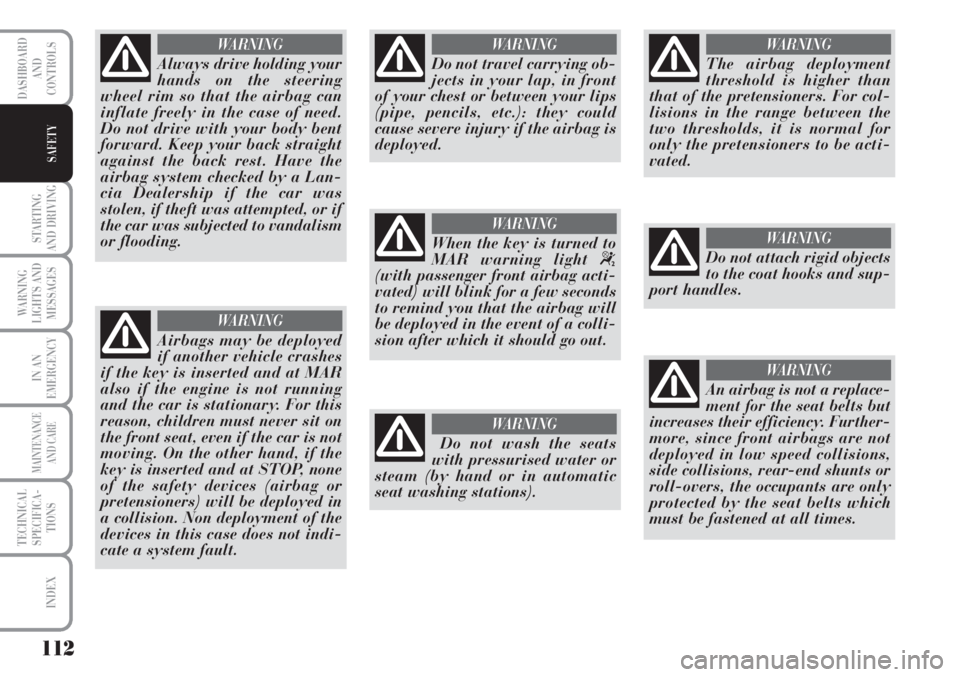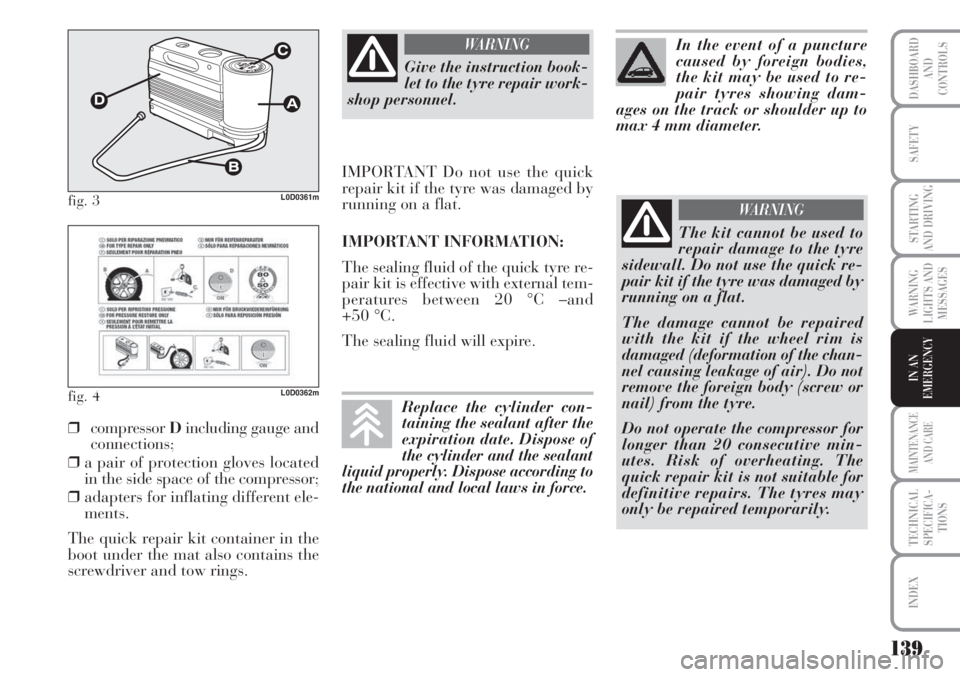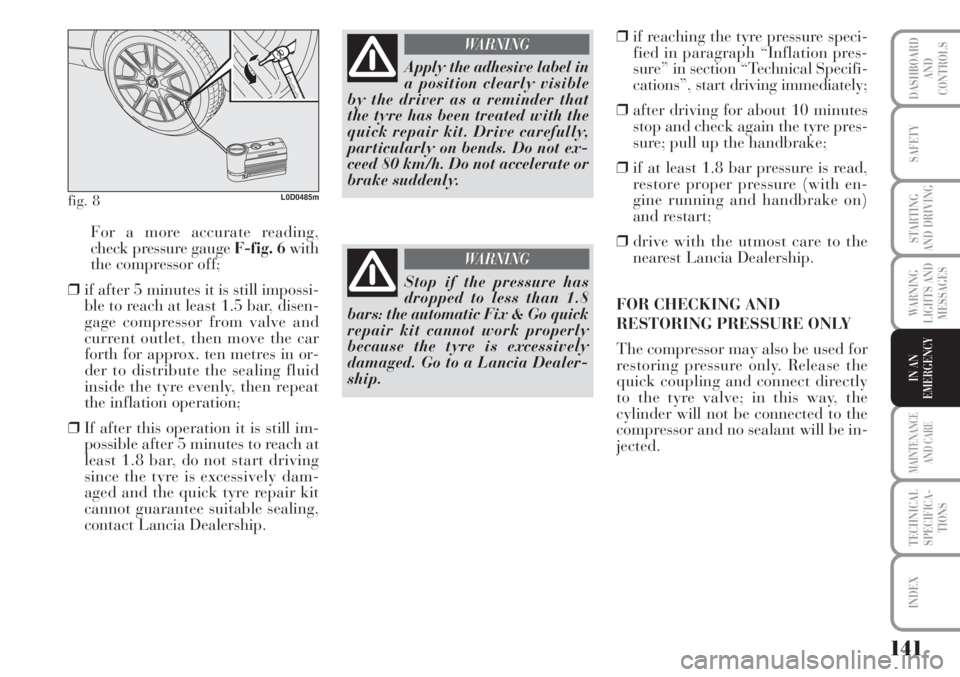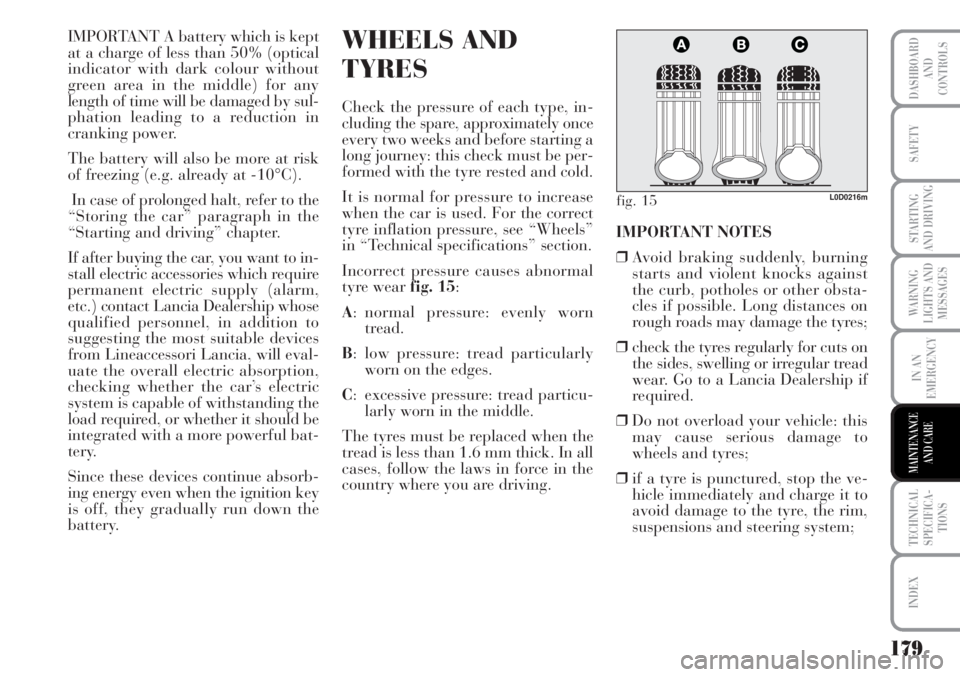run flat Lancia Musa 2010 Owner handbook (in English)
[x] Cancel search | Manufacturer: LANCIA, Model Year: 2010, Model line: Musa, Model: Lancia Musa 2010Pages: 218, PDF Size: 3.71 MB
Page 113 of 218

112
STARTING
AND DRIVING
WARNING
LIGHTS AND
MESSAGES
IN AN
EMERGENCY
MAINTENANCE
AND CARE
TECHNICAL
SPECIFICA-
TIONS
INDEX
DASHBOARD
AND
CONTROLS
SAFETY
Always drive holding your
hands on the steering
wheel rim so that the airbag can
inflate freely in the case of need.
Do not drive with your body bent
forward. Keep your back straight
against the back rest. Have the
airbag system checked by a Lan-
cia Dealership if the car was
stolen, if theft was attempted, or if
the car was subjected to vandalism
or flooding.
WARNING
Do not travel carrying ob-
jects in your lap, in front
of your chest or between your lips
(pipe, pencils, etc.): they could
cause severe injury if the airbag is
deployed.
WARNING
The airbag deployment
threshold is higher than
that of the pretensioners. For col-
lisions in the range between the
two thresholds, it is normal for
only the pretensioners to be acti-
vated.
WARNING
When the key is turned to
MAR warning light
“(with passenger front airbag acti-
vated) will blink for a few seconds
to remind you that the airbag will
be deployed in the event of a colli-
sion after which it should go out.
WARNING
Do not wash the seats
with pressurised water or
steam (by hand or in automatic
seat washing stations).
WARNING
An airbag is not a replace-
ment for the seat belts but
increases their efficiency. Further-
more, since front airbags are not
deployed in low speed collisions,
side collisions, rear-end shunts or
roll-overs, the occupants are only
protected by the seat belts which
must be fastened at all times.
WARNING
Do not attach rigid objects
to the coat hooks and sup-
port handles.
WARNING
Airbags may be deployed
if another vehicle crashes
if the key is inserted and at MAR
also if the engine is not running
and the car is stationary. For this
reason, children must never sit on
the front seat, even if the car is not
moving. On the other hand, if the
key is inserted and at STOP, none
of the safety devices (airbag or
pretensioners) will be deployed in
a collision. Non deployment of the
devices in this case does not indi-
cate a system fault.
WARNING
Page 140 of 218

139
WARNING
LIGHTS AND
MESSAGES
MAINTENANCE
AND CARE
TECHNICAL
SPECIFICA-
TIONS
INDEX
DASHBOARD
AND
CONTROLS
SAFETY
STARTING
AND DRIVING
IN AN
EMERGENCY
fig. 3L0D0361m
fig. 4L0D0362m
❒compressor Dincluding gauge and
connections;
❒a pair of protection gloves located
in the side space of the compressor;
❒adapters for inflating different ele-
ments.
The quick repair kit container in the
boot under the mat also contains the
screwdriver and tow rings.
Give the instruction book-
let to the tyre repair work-
shop personnel.
WARNING
IMPORTANT Do not use the quick
repair kit if the tyre was damaged by
running on a flat.
IMPORTANT INFORMATION:
The sealing fluid of the quick tyre re-
pair kit is effective with external tem-
peratures between 20 °C –and
+50 °C.
The sealing fluid will expire.
The kit cannot be used to
repair damage to the tyre
sidewall. Do not use the quick re-
pair kit if the tyre was damaged by
running on a flat.
The damage cannot be repaired
with the kit if the wheel rim is
damaged (deformation of the chan-
nel causing leakage of air). Do not
remove the foreign body (screw or
nail) from the tyre.
Do not operate the compressor for
longer than 20 consecutive min-
utes. Risk of overheating. The
quick repair kit is not suitable for
definitive repairs. The tyres may
only be repaired temporarily.
WARNING
In the event of a puncture
caused by foreign bodies,
the kit may be used to re-
pair tyres showing dam-
ages on the track or shoulder up to
max 4 mm diameter.
Replace the cylinder con-
taining the sealant after the
expiration date. Dispose of
the cylinder and the sealant
liquid properly. Dispose according to
the national and local laws in force.
Page 142 of 218

141
WARNING
LIGHTS AND
MESSAGES
MAINTENANCE
AND CARE
TECHNICAL
SPECIFICA-
TIONS
INDEX
DASHBOARD
AND
CONTROLS
SAFETY
STARTING
AND DRIVING
IN AN
EMERGENCY
For a more accurate reading,
check pressure gauge F-fig. 6with
the compressor off;
❒if after 5 minutes it is still impossi-
ble to reach at least 1.5 bar, disen-
gage compressor from valve and
current outlet, then move the car
forth for approx. ten metres in or-
der to distribute the sealing fluid
inside the tyre evenly, then repeat
the inflation operation;
❒If after this operation it is still im-
possible after 5 minutes to reach at
least 1.8 bar, do not start driving
since the tyre is excessively dam-
aged and the quick tyre repair kit
cannot guarantee suitable sealing,
contact Lancia Dealership.
fig. 8L0D0485m
Apply the adhesive label in
a position clearly visible
by the driver as a reminder that
the tyre has been treated with the
quick repair kit. Drive carefully,
particularly on bends. Do not ex-
ceed 80 km/h. Do not accelerate or
brake suddenly.
WARNING
Stop if the pressure has
dropped to less than 1.8
bars: the automatic Fix & Go quick
repair kit cannot work properly
because the tyre is excessively
damaged. Go to a Lancia Dealer-
ship.
WARNING
❒if reaching the tyre pressure speci-
fied in paragraph “Inflation pres-
sure” in section “Technical Specifi-
cations”, start driving immediately;
❒after driving for about 10 minutes
stop and check again the tyre pres-
sure; pull up the handbrake;
❒if at least 1.8 bar pressure is read,
restore proper pressure (with en-
gine running and handbrake on)
and restart;
❒drive with the utmost care to the
nearest Lancia Dealership.
FOR CHECKING AND
RESTORING PRESSURE ONLY
The compressor may also be used for
restoring pressure only. Release the
quick coupling and connect directly
to the tyre valve; in this way, the
cylinder will not be connected to the
compressor and no sealant will be in-
jected.
Page 180 of 218

179
WARNING
LIGHTS AND
MESSAGES
TECHNICAL
SPECIFICA-
TIONS
INDEX
DASHBOARD
AND
CONTROLS
SAFETY
STARTING
AND DRIVING
IN AN
EMERGENCY
MAINTENANCE
AND CARE
IMPORTANT A battery which is kept
at a charge of less than 50% (optical
indicator with dark colour without
green area in the middle) for any
length of time will be damaged by sul-
phation leading to a reduction in
cranking power.
The battery will also be more at risk
of freezing (e.g. already at -10°C).
In case of prolonged halt, refer to the
“Storing the car” paragraph in the
“Starting and driving” chapter.
If after buying the car, you want to in-
stall electric accessories which require
permanent electric supply (alarm,
etc.) contact Lancia Dealership whose
qualified personnel, in addition to
suggesting the most suitable devices
from Lineaccessori Lancia, will eval-
uate the overall electric absorption,
checking whether the car’s electric
system is capable of withstanding the
load required, or whether it should be
integrated with a more powerful bat-
tery.
Since these devices continue absorb-
ing energy even when the ignition key
is off, they gradually run down the
battery.WHEELS AND
TYRES
Check the pressure of each type, in-
cluding the spare, approximately once
every two weeks and before starting a
long journey: this check must be per-
formed with the tyre rested and cold.
It is normal for pressure to increase
when the car is used. For the correct
tyre inflation pressure, see “Wheels”
in “Technical specifications” section.
Incorrect pressure causes abnormal
tyre wearfig. 15:
A: normal pressure: evenly worn
tread.
B: low pressure: tread particularly
worn on the edges.
C: excessive pressure: tread particu-
larly worn in the middle.
The tyres must be replaced when the
tread is less than 1.6 mm thick. In all
cases, follow the laws in force in the
country where you are driving.IMPORTANT NOTES
❒Avoid braking suddenly, burning
starts and violent knocks against
the curb, potholes or other obsta-
cles if possible. Long distances on
rough roads may damage the tyres;
❒check the tyres regularly for cuts on
the sides, swelling or irregular tread
wear. Go to a Lancia Dealership if
required.
❒Do not overload your vehicle: this
may cause serious damage to
wheels and tyres;
❒if a tyre is punctured, stop the ve-
hicle immediately and charge it to
avoid damage to the tyre, the rim,
suspensions and steering system;
fig. 15L0D0216m